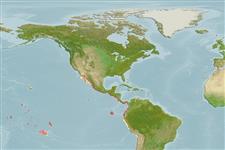Environment: milieu / climate zone / depth range / distribution range
Ecologia
marinhas; estuarina. Tropical; 35°N - 20°S
Eastern Pacific: Mexico to Ecuador. Also reported from Paita, Peru (Ref. 5530).
Tamanho / Peso / Idade
Maturity: Lm ? range ? - ? cm
Max length : 28.2 cm TL macho/indeterminado; (Ref. 124487); common length : 20.0 cm FL macho/indeterminado; (Ref. 9283); peso máx. Publicado: 145.24 g (Ref. 124487)
Descrição breve
Chaves de identificação | Morfologia | Morfometria
Body strongly compressed and elongate (depth from 4.5 to 5.4 times in standard length); posterior end of upper jaw reaching middle of eye; upper jaw teeth small and villiform; lower branch of first gill arch with 19 to 22 gill rakers; scales small but visible, needle-shaped, embedded in the skin; back dark gray; belly and flanks silvery or blue gray with yellow highlights; dorsal and anal fins charcoal colored; pelvic fins white; pectoral and caudal fins yellow (Ref. 55763).
Adults are found in littoral waters (Ref. 9283). They tolerate low salinities and may temporarily penetrate estuarine waters (Ref. 9283). The dorsal and anal spines are connected to venomous glands that can cause painful wounds (Ref. 9283). Marketed fresh and salted or dried (Ref. 9283).
Life cycle and mating behavior
Maturidade | Reprodução | Desova | Ovos | Fecundidade | Larvas
Smith-Vaniz, W.F., 1995. Carangidae. Jureles, pámpanos, cojinúas, zapateros, cocineros, casabes, macarelas, chicharros, jorobados, medregales, pez pilota. p. 940-986. In W. Fischer, F. Krupp, W. Schneider, C. Sommer, K.E. Carpenter and V. Niem (eds.) Guia FAO para Identification de Especies para lo Fines de la Pesca. Pacifico Centro-Oriental. 3 Vols. FAO, Rome. (Ref. 9283)
Categoria na Lista Vermelha da IUCN (Ref. 130435: Version 2024-1)
Utilização humana
Pescarias: pouco comercial
Ferramentas
Relatórios especiais
Descarregue XML
Fontes da internet
Estimates based on models
Preferred temperature (Ref.
123201): 20.4 - 29, mean 25.9 °C (based on 288 cells).
Phylogenetic diversity index (Ref.
82804): PD
50 = 0.5312 [Uniqueness, from 0.5 = low to 2.0 = high].
Bayesian length-weight: a=0.00708 (0.00435 - 0.01153), b=2.93 (2.79 - 3.07), in cm total length, based on LWR estimates for this species & Genus-body shape (Ref.
93245).
Nível Trófico (Ref.
69278): 4.2 ±0.73 se; based on food items.
Resiliência (Ref.
120179): Elevada, tempo mínimo de duplicação da população menor que 15 meses (Preliminary K or Fecundity.).
Fishing Vulnerability (Ref.
59153): Low vulnerability (18 of 100).
Nutrients (Ref.
124155): Calcium = 217 [128, 551] mg/100g; Iron = 2.13 [1.22, 4.01] mg/100g; Protein = 19.4 [18.2, 20.6] %; Omega3 = 0.322 [0.175, 0.610] g/100g; Selenium = 32.4 [15.8, 67.9] μg/100g; VitaminA = 35.9 [10.5, 107.6] μg/100g; Zinc = 1.37 [0.94, 1.99] mg/100g (wet weight);
